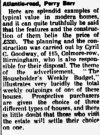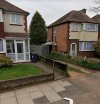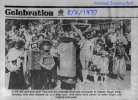-
Welcome to this forum . We are a worldwide group with a common interest in Birmingham and its history. While here, please follow a few simple rules. We ask that you respect other members, thank those who have helped you and please keep your contributions on-topic with the thread.
We do hope you enjoy your visit. BHF Admin Team
You are using an out of date browser. It may not display this or other websites correctly.
You should upgrade or use an alternative browser.
You should upgrade or use an alternative browser.
Atlantic Road Kingstanding
- Thread starter Vivienne14
- Start date
That’s great Oldmohawk and Jonob ! I think it’s the back garden of the house I was born in - Atlantic Road, Kingstanding. I think there’s a pond behind my head - we definitely had a pond. And the house in the distance is lower than our house - must be the houses in Corbridge Avenue. We used to go down there and play, there was a gulley running along the end of the garden and you could cut through to Corbridge. I have a later photo somewhere looking across there from our upstairs window so shall have to dig it out.
Great work all, many thanks. Viv.
Great work all, many thanks. Viv.
Yes MWS !! That’s freaky. Don’t remember there being any garden ornaments, gnomes etc in the garden. Although my dad did have a weird sense of humour. I wonder if it’s from the photographic film. Can you get one image superimposed on another ? Viv.
mw0njm.
A Brummie Dude
yesYes MWS !! That’s freaky. Don’t remember there being any garden ornaments, gnomes etc in the garden. Although my dad did have a weird sense of humour. I wonder if it’s from the photographic film. Can you get one image superimposed on another ? Viv.
Multiple exposure techniques
Analogue
Double exposure made using a film camera
In photography and cinematography, multiple exposure is a technique in which the camera shutter is opened more than once to expose the film multiple times, usually to different images. The resulting image contains the subsequent image/s superimposed over the original. The technique is sometimes used as an artistic visual effect and can be used to create ghostly images or to add people and objects to a scene that were not originally there. It is frequently used in photographic hoaxes.
It is considered easiest to have a manual winding camera for double exposures. On automatic winding cameras, as soon as a picture is taken the film is typically wound to the next frame. Some more advanced automatic winding cameras have the option for multiple exposures but it must be set before making each exposure. Manual winding cameras with a multiple exposure feature can be set to double-expose after making the first exposure.
Since shooting multiple exposures will expose the same frame multiple times, negative exposure compensation must first be set to avoid overexposure. For example, to expose the frame twice with correct exposure, a −1 EV compensation have to be done, and −2 EV for exposing four times. This may not be necessary when photographing a lit subject in two (or more) different positions against a perfectly dark background, as the background area will be essentially unexposed.
Medium to low light is ideal for double exposures. A tripod may not be necessary if combining different scenes in one shot. In some conditions, for example, recording the whole progress of a lunar eclipse in multiple exposures, a stable tripod is essential.
More than two exposures can be combined, with care not to overexpose the film.
yes
Multiple exposure techniques
Analogue
Double exposure made using a film camera
In photography and cinematography, multiple exposure is a technique in which the camera shutter is opened more than once to expose the film multiple times, usually to different images. The resulting image contains the subsequent image/s superimposed over the original. The technique is sometimes used as an artistic visual effect and can be used to create ghostly images or to add people and objects to a scene that were not originally there. It is frequently used in photographic hoaxes......
I wonder if my Dad was experimenting with the film then. It’s the sort of thing I can imagine him doing. This afternoon have rifled through some old photos. Didn’t find the one I’m looking for but found this one. To the left of my brothers hand is a house and I think the edge of next doors garage. Looks about right to me. This was definitely taken at Atlantic Road 1948/9. The garden looks like mostly rubble. There’s still part of an Anderson shelter at the back. So my dad did well to convert this into the apparently lush garden by about 1955.
Interestingly if you look in the distance over my brothers shoulder iits where Great Barr Comp was built. We had a good view of it from our house, albeit in the far distance.
Think I shall start an Atlantic Road thread and move the posts on my query to it. Thanks all. Viv. Edit this thread now created.

oldMohawk
gone but not forgotten
This aerial view dated 1938 shows Atlantic Road running from bottom left to Dyas Road near top right. It is a crop from a view in a 2017 post see link below ...

from
 birminghamhistory.co.uk
birminghamhistory.co.uk
from
Childhood Memories
Re: Cadbury's Bournville Pretty good, though thinking about it now it was probably a scam. If his method of predicting footie results was any good he`d be living a life of Reilly in the carribean. Yes indeed! I remember thinking at the time, Why would anyone sell info on how to win the pools...
 birminghamhistory.co.uk
birminghamhistory.co.uk
Last edited:
Thanks Oldmohawk. Using Oldmohawk’s aeriel view, I’ve marked our house yellow and the alleyway leading down to Corbridge Avenue blue. That alleyway down to Corbridge was a steep, high sided drop, with loose gravelly soil. So not really a place for kids to play. But this was our playground and we were there nearly every day. I think all the alleyways which ran behind all of the housing in that area have now been gated and locked off. No wonder really, they would have been the perfect places for all sorts of undesirable activity.
If you look further along Atlantic Road to the right, you’ll see a gap in the houses. These weren’t ‘filled in’ until, I think, the 1950s. I mentioned this on another thread and wondered if it was left to allow supplies (eg local sand from the sandpits) to be delivered to the building site for the housing.
Viv.

If you look further along Atlantic Road to the right, you’ll see a gap in the houses. These weren’t ‘filled in’ until, I think, the 1950s. I mentioned this on another thread and wondered if it was left to allow supplies (eg local sand from the sandpits) to be delivered to the building site for the housing.
Viv.
Found the photo I was looking for. This would be about 1960ish. It was taken from our bedroom window. I notice the garage in what I thought was our next door neighbours garden was in fact in the garden of the next door neighbour but one.
The view is looking towards Dyas Road and Old Oscott Lane. So from my yellow dot (in adapted OM’s image in post #10) it is looking across Corbridge Avenue. This would be over 20 years after OMs aeriel view in post #9. All the land in the aerial view being filled with housing. Viv.

The view is looking towards Dyas Road and Old Oscott Lane. So from my yellow dot (in adapted OM’s image in post #10) it is looking across Corbridge Avenue. This would be over 20 years after OMs aeriel view in post #9. All the land in the aerial view being filled with housing. Viv.

Last edited:
Christmas Day c1962. Me (left), Andrea (middle), Paul (right). We all had these scooters/bike for Christmas. Also posting a current view of the houses in the background. It’s notable that all the privet hedges have gone in favour of off-street parking.
The trees, probably planted in the 1930s have slowly matured. And surprisingly the grass verges are still there. We had a tree on the verge outside our house and, at one time we planted an ornamental grass at the base. Don’t think it lasted long with all the dogs that used to freely roam the streets in those days.
Did a lot of tap dancing, roller skating and skipping on that side of the road as I had a good friend who lived in one of those houses.
Viv.


The trees, probably planted in the 1930s have slowly matured. And surprisingly the grass verges are still there. We had a tree on the verge outside our house and, at one time we planted an ornamental grass at the base. Don’t think it lasted long with all the dogs that used to freely roam the streets in those days.
Did a lot of tap dancing, roller skating and skipping on that side of the road as I had a good friend who lived in one of those houses.
Viv.


mw0njm.
A Brummie Dude
nice pic. i liked the brick arch porchesChristmas Day c1962. Me (left), Andrea (middle), Paul (right). We all had these scooters/bike for Christmas. Also posting a current view of the houses in the background. It’s notable that all the privet hedges have gone in favour of off-street parking.
The trees, probably planted in the 1930s have slowly matured. And surprisingly the grass verges are still there. We had a tree on the verge outside our house and, at one time we planted an ornamental grass at the base. Don’t think it lasted long with all the dogs that used to freely roam the streets in those days.
Did a lot of tap dancing, roller skating and skipping on that side of the road as I had a good friend who lived in one of those houses.
Viv.
View attachment 152117
View attachment 152116
Yes all originally red brick arches. The porch had a shelf on one side in ours. Don’t know if they had that when they were built. Just above the shelf was our Co-op divi number for milk and bread deliveries. If you got forensics round there today, you’d probably be able to find the graphite pencil traces. Might even find some unclaimed divi !!
mw0njm.
A Brummie Dude
Yes all originally red brick arches. The porch had a shelf on one side in ours. Don’t know if they had that when they were built. Just above the shelf was our Co-op divi number for milk and bread deliveries. If you got forensics round there today, you’d probably be able to find the graphite pencil traces. Might even find some unclaimed divi !!
There was rear access for all residents to the gulley that ran at the back of all the houses in Atlantic Road. The houses weren’t built with garages, but some people had them built at the end of their gardens. The gardens were very long. When I visited about 20 years ago, the gulleys had by then all been gated off. Presumably you had to have a key to access the gulley. Viv.
 Front garden c1963. Lawn nicely mowed, edges cut using a plank of wood and a spade, hedges clipped and border weeded. On each corner was a laurel bush with green, glossy leaves. Privet bordered the garden on all sides, against a low brick wall in front. Crazy paved path up to the front door. You can see the grass verges next to them road, these ran along the whole road, planted with trees at intervals. All fairly typical for houses in this road at the time. When I visited 20+ years later, this was sadly all overgrown.
Front garden c1963. Lawn nicely mowed, edges cut using a plank of wood and a spade, hedges clipped and border weeded. On each corner was a laurel bush with green, glossy leaves. Privet bordered the garden on all sides, against a low brick wall in front. Crazy paved path up to the front door. You can see the grass verges next to them road, these ran along the whole road, planted with trees at intervals. All fairly typical for houses in this road at the time. When I visited 20+ years later, this was sadly all overgrown.I’m with my friend, Sue, who lived across the road. Viv.
Moving to the back garden, this was the door and windows to the living room. Note the Hollywood-style net curtains, Mum loved this stuff. These were later replaced with modern 1960s mesh; the one that was very popular with the oval holes all over. We also had a back door at the side of the house into the kitchen.
I’m here holding Mandy, the aggressive rabbit. Had a nasty habit of biting you. I had another Dutch rabbit, black and white, less aggressive. I’m wearing a blue and white polka dot glazed cotton dress, gathered at the hip and decorated with a polka dot bow. Loved this dress and wore it day in, day out in the summer.
The tree you can see was an ornamental cherry which in time would start to uproot next doors veranda. Think it must have eventually been chopped down, but it used to have the most wonderful glossy, brown peeling bark and pink blossom.
You can’t see the ground but there was a crazy paved area - today you’d call it a ‘patio’ - but in the 1960s it didn't have a name. Set into the crazy paving was one perfectly large, round stone. No idea where that came from. Behind me would have been a growing mound of ‘tat’ as my mum called it - old Anderson shelter sheets, a half-assembled motorbike, all leaning up against the coal shed wall.
One of our neighbours two doors up had his own well. He was in construction and had built access to it towards the bottom of his garden. I assume it was a natural well.
Our garden was roughly in two sections; plants, pond and lawn with a sunken path running through the middle. The plants and pond on the one side and the lawn on the other were raised up about 12” from the pathway, the sides lined with rock. Can only assume all those materials were found in the garden when they bought the house.
The bottom half of the garden had vegetables and fruit and a shed. Some vegetables and fruit were grown in massive cages, constructed from old piping and mesh. This section was divided from the top half of the garden with a flimsy fence, much like trellising. A vivid memory is a small apple tree which produced the most delicious small, red apples. Can still taste them today !
Beyond the garden was the gully. We didn’t have access, possibly for security reasons, but some neighbours did,

I’m here holding Mandy, the aggressive rabbit. Had a nasty habit of biting you. I had another Dutch rabbit, black and white, less aggressive. I’m wearing a blue and white polka dot glazed cotton dress, gathered at the hip and decorated with a polka dot bow. Loved this dress and wore it day in, day out in the summer.
The tree you can see was an ornamental cherry which in time would start to uproot next doors veranda. Think it must have eventually been chopped down, but it used to have the most wonderful glossy, brown peeling bark and pink blossom.
You can’t see the ground but there was a crazy paved area - today you’d call it a ‘patio’ - but in the 1960s it didn't have a name. Set into the crazy paving was one perfectly large, round stone. No idea where that came from. Behind me would have been a growing mound of ‘tat’ as my mum called it - old Anderson shelter sheets, a half-assembled motorbike, all leaning up against the coal shed wall.
One of our neighbours two doors up had his own well. He was in construction and had built access to it towards the bottom of his garden. I assume it was a natural well.
Our garden was roughly in two sections; plants, pond and lawn with a sunken path running through the middle. The plants and pond on the one side and the lawn on the other were raised up about 12” from the pathway, the sides lined with rock. Can only assume all those materials were found in the garden when they bought the house.
The bottom half of the garden had vegetables and fruit and a shed. Some vegetables and fruit were grown in massive cages, constructed from old piping and mesh. This section was divided from the top half of the garden with a flimsy fence, much like trellising. A vivid memory is a small apple tree which produced the most delicious small, red apples. Can still taste them today !
Beyond the garden was the gully. We didn’t have access, possibly for security reasons, but some neighbours did,

Last edited:
Dewsbury Grove has gone the same way, I left in 1970 and viewing on Google earth really shows how times have changed. I always parked in the road but see double yellows have invaded.Christmas Day c1962. Me (left), Andrea (middle), Paul (right). We all had these scooters/bike for Christmas. Also posting a current view of the houses in the background. It’s notable that all the privet hedges have gone in favour of off-street parking.
The trees, probably planted in the 1930s have slowly matured. And surprisingly the grass verges are still there. We had a tree on the verge outside our house and, at one time we planted an ornamental grass at the base. Don’t think it lasted long with all the dogs that used to freely roam the streets in those days.
Did a lot of tap dancing, roller skating and skipping on that side of the road as I had a good friend who lived in one of those houses.
Viv.
View attachment 152117
View attachment 152116
Eric Gibson
master brummie
Birdbrook Road the same, I built a large garage at the back but I note the front garden's gone and a car park there now.
Opposite my house was an open field but they built the driving test place on that after we left.
Opposite my house was an open field but they built the driving test place on that after we left.
Remember the Kingfisher pub Eric on Birdbrook. Mum, Dad and I went there a couple of times in the early 1960s. Vaguely remember sitting outside, but don’t remember the interior. It wouldn’t have been my Dad’s cup of tea in any case as he didn’t like modern places.
You could also see the pub from our upstairs back bedroom. Viv.
You could also see the pub from our upstairs back bedroom. Viv.
Richard Dye
master brummie
Great work by Jonob & oldMohawk!That’s great Oldmohawk and Jonob ! I think it’s the back garden of the house I was born in - Atlantic Road, Kingstanding. I think there’s a pond behind my head - we definitely had a pond. And the house in the distance is lower than our house - must be the houses in Corbridge Avenue. We used to go down there and play, there was a gulley running along the end of the garden and you could cut through to Corbridge. I have a later photo somewhere looking across there from our upstairs window so shall have to dig it out.
Great work all, many thanks. Viv.
Eric Gibson
master brummie
I don't do pubs Viv.  never found booze any sort of pleasure. I recall going to a Funeral do at the Boars Head once and seeing dozens of people trying to fight their way through the crowd to the bar.
never found booze any sort of pleasure. I recall going to a Funeral do at the Boars Head once and seeing dozens of people trying to fight their way through the crowd to the bar. 
Richard Dye
master brummie
Eric, I like a few drinks but it seems like funerals, weddings and New Years Eve is like feeding time at the zoo! So we usually abstain.I don't do pubs Viv.never found booze any sort of pleasure. I recall going to a Funeral do at the Boars Head once and seeing dozens of people trying to fight their way through the crowd to the bar.

Look at this price in the 1930s ! Pity they were prone to damp in later years. Note address reference is Perry Barr. I also remember Erdington dbeing used in the address during the 1950s/60s The reference to Cyril Goodway must have been the origin of the name Goodway Road. Viv

Source: British Newspaper Archive

Source: British Newspaper Archive
Last edited:
This is a random memory. When I lived in Atlantic Road I used this gulleyway every day, either as a short cut to school (Kingsthorne) or up to Hawthorn Road shops. In those days all the gullies were open, no gates or fences stopping access.
My memory of the gulley itself was a dug out channel, with soil piled up on either side. When it rained the water would flow down it but you didn't get too dirty. I think the reason would have been sand. I remember the 'soil wasn't dark and had a more gravelly texture. So I'm thinking this and much of this part of Atlantic Road were part of the sandhills dropping down towards Great Barr. if you look at the modern day image the track looks a light colour.
The other thing that springs to mind is sheltering from the rain under an overhanging Hawthorn tree, which would have been in the back garden of the house on the right.i wonder if it's still there. It's funny the memories that pop up from the past.

My memory of the gulley itself was a dug out channel, with soil piled up on either side. When it rained the water would flow down it but you didn't get too dirty. I think the reason would have been sand. I remember the 'soil wasn't dark and had a more gravelly texture. So I'm thinking this and much of this part of Atlantic Road were part of the sandhills dropping down towards Great Barr. if you look at the modern day image the track looks a light colour.
The other thing that springs to mind is sheltering from the rain under an overhanging Hawthorn tree, which would have been in the back garden of the house on the right.i wonder if it's still there. It's funny the memories that pop up from the past.





